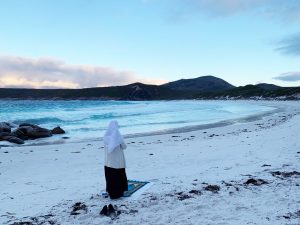MY STORY
Our community is made up of people from many different cultural backgrounds. Read some of their stories here and share yours with us by emailing admin@esperancecommunityarts.org.au .We’d love to hear from you!
Luc Lemary interview by Aly Jennings
Interview to Luc Lemary about growing up in Madagascar. Click HERE to listen. Don’t miss Aly Jennings program “Afrobeats” every Saturday at 1pm in 103.9 Hope FM.
Mario Abram
Thuriyya Ibrahim - Interview in The Weekender about Ramadam

- Could you please tell Esperance Weekender readers what Ramadan is and what it means to you?
- How do you usually celebrate the feast, what is your celebration plan this year, and what do you feel about it?
- What is it like to finish the fasting month and celebrate its end?
- What is it like to wear Hijab in a small community like Esperance, where Hijab is not commonly seen?
Eid Mubarak (Greeting used for the end of Ramadan – Blessed Feast) – Ramadan 2022
Ramadan is a time of fasting observed by the Muslim community during the ninth month of the Islamic lunar calendar and begins and ends with the sighting of the moon. This means no food or drink is taken from sunrise to sunset and people are encouraged to join in nightly prayers at the mosque (Tarawih). It is also a time to consider others by giving charity, inviting someone to break the fast with you, or to give away food to others. I think of this as a special time for spiritual mindfulness and creating time away from normal life.
The end of Ramadan is celebrated the day after the new moon is sighted and is called Eid ul Fitr, the ‘Feast of Breaking the Fast.’ To greet someone on Eid Day you would say ‘Eid Mubarak’ meaning ‘Blessed Feast,’ but also taken as happy Eid Day.
It is tradition for the Muslim community to come together in the mosque or in an open space for Eid Day prayers. Sharing of food is very much a part of the celebrations with older people staying at home and younger people and families visiting different people during the next few days and taking specially prepared treats. While I will enjoy celebrating Eid with an early morning at Cape Le Grande and then catching up with friends, I also miss being part of community celebrations with other Muslims.
There are so many good things that happen during Ramadan, and even though Eid Day is eagerly anticipated and a time of great celebration, I also miss the space it creates in a life that soon gets busy with other things.
Wearing hijab is a part of who I am, and I feel is mostly accepted in this community. It is good to live in a society where women rightfully have a choice about what they wear, no matter how they choose to live their life. That is why embracing diversity in a community is so important, as it gives everyone a voice and helps us to consider other people’s experiences, and what is meaningful for them.
Gislaine Cristina Bueno Smania

I am an only child, mother, wife, and a graduate in labor law.
I started my professional life at the age of twelve working as a nanny for one year. At thirteen years of age, I went to work in a clothing factory, where I worked for six years, going through various sections. The experience that affected me the most was Human Resources, and this is the reason for which, years later, I became a labor lawyer.
A tradition that I love in my country is Christmas, because it is a big country, and the Christmas customs sometimes vary according to the different regions. Christmas is always the most special time of the year, for me, my family gets together, we buy gifts for each other, watch traditional Christmas movies, and of course satisfy that craving for traditional dishes that we only eat at that time. For us Brazilians, the greatest tradition in terms of Christmas dishes is the Christmas turkey! The other traditions are based on other Christmas traditions around the world: decorations, turkey, lights, etc.
I don’t miss this tradition even though I live in another country, because my family and I decided not to give up on this date together, regardless of where we are living. We get together for this date, which is not very easy, having moved fifteen times, as my husband is an engineer in a multinational company. I do miss my children very much and my mother, mother-in-law, and my grandmother.
I am not surprised by the amount of change as this has allowed us to get to know the country, cities, and special people, because in every corner we have passed, we have lived beautiful stories. Including the current one in Esperance, a quiet town, with the most beautiful sky I’ve ever seen. In life there are wonderful beaches, but in winter it is very cold (we Brazilians are from the southeast and we are not used to the cold. I have been missing the heat of Brazil a little). Other than that, the town is welcoming, with very attentive people.
Speaking of welcoming, because I don’t speak much of the English language, I have found people who are helping me learn language and crafts, and the love that volunteering represents in this town. This has contributed a lot to my adaptation in a country so different from mine. Language is the biggest challenge for me as I would like to be more involved in community life.
Finally, I have to thank God first for every opportunity presented, and my husband and children for always being united, even if sometimes separated by an ocean.
Gislaine Cristina Bueno Smania is Brazilian and wrote this text in her original lamguage, Portuguese.
Jimena Ramon Montemayor - Dia de Muertos
Although many people believe it is just “the Mexican Halloween”, Día de Muertos (Day of the Dead) is actually a three-day festivity to celebrate that a portal between our world and the spirit world is open, allowing our loved ones who have passed to come back to Earthside to spend time with us.
It is my favorite celebration in Mexico and it is not only because of the floral displays and the typical food that is prepared during this season, but because it is a unique and colourful celebration of life.
In my region, Yucatan, Day of the Dead is called Hanal Pixan (pronounced ha-nawl peesh-awn) and translated to “Food for the souls” in the Mayan language. It is celebrated from the 31st of October to the 2nd of November. The first night honours the children who have passed, November 1st honours adults, while the last day is dedicated to everyone who has passed.
There are a few differences in the altars that are prepared for this festival, depending on the state and the day, but they are all filled with the favorite foods of the loved ones they are dedicated to, symbolic items, candles and many flowers, especially the beautiful, yellow, vibrant Cempasuchil (Mexican marigold) which helps guide the spirits to the altars. To celebrate we often eat pan de muerto (bread of the dead) which is a bread infused with orange zest and covered with sugar; mucbipollo, a delicious dish of chicken meat in crispy corn dough, wrapped in banana leaf and buried for hours to cook; xec, a spicy fruit salad and many other delicacies.
If you find this celebration meaningful, you could create an altar for your loved ones at home. There is no better tribute for those that are gone, that to celebrate their life, honour them, and continue living.